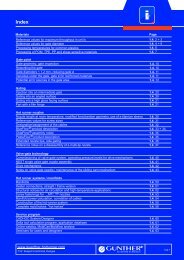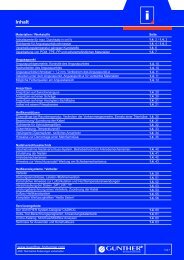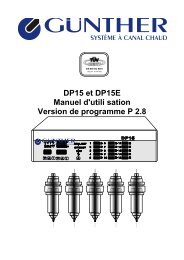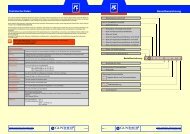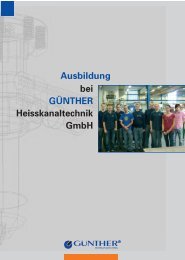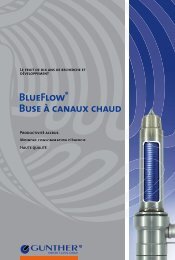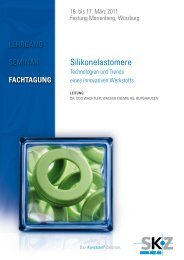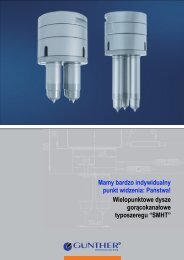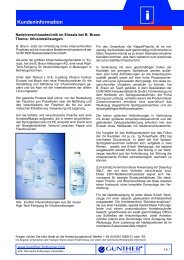Heißkanaldüsen Typ SLT/-DLT Customer information
Heißkanaldüsen Typ SLT/-DLT Customer information
Heißkanaldüsen Typ SLT/-DLT Customer information
You also want an ePaper? Increase the reach of your titles
YUMPU automatically turns print PDFs into web optimized ePapers that Google loves.
1.5. 25<br />
iA<br />
<strong>Heißkanaldüsen</strong> <strong>Typ</strong> <strong>SLT</strong>/-<strong>DLT</strong><br />
Nozzle design for injection moulding on tandem tools<br />
To avoid these disadvantages, the hot-runner specialist<br />
in consultation with the heater supplier developed a<br />
special solution for the second level in the form of a<br />
transfer nozzle, which on the outside is identical to the<br />
suppliers' SHT nozzles with two-part shaft. Here, the<br />
basic idea of two nozzles was maintained and optimised<br />
so that they could be produced in just one component.<br />
Fig. The special nozzle design in the second parting level cuts costs<br />
and reduces the construction size.<br />
In the new system an open passage was fitted on the<br />
cold-runner side for the first parting level. During the<br />
injection into the first level a plastic plate with a defined<br />
wall thickness is formed which allows injection through to<br />
the second level. Before that this plate provides a closure<br />
between the first and second parting levels. When<br />
injecting into the second level, the melt pressure and<br />
enthalpy of the melt are sufficient to inject the melt jet<br />
through the plate to the transfer nozzle.<br />
<strong>Customer</strong> <strong>information</strong><br />
Based on T-Mould's experience and the injection trials<br />
conducted in the hot-runner specialist's own pilot plant<br />
experimental facility, it was possible to define the wall<br />
thickness of the plate in a way that would ensure that the<br />
process would function perfectly as of the first shot.<br />
The process with the aid of the plastic plate has al-ready<br />
been in use in practice for a long time but so far usually<br />
with polymers that have not been reinforced. In the<br />
current case a semi-crystalline, glass-fibre reinforced<br />
material is used, which makes greater demands on<br />
process reliability.<br />
Low losses during thermal conduction<br />
In a very short time GÜNTHER and the heating supplier<br />
were able to find a solution in terms of the best possible<br />
way to heat the transfer nozzle. A two-component shaft<br />
with titanium cap as well as nozzle heating adapted for<br />
this application make it possible to minimise the heat loss<br />
in the nozzle so that only very little is lost in the conduction<br />
of heat to the nozzle tip. The nozzle heating<br />
consists of only one component so that there are no<br />
significantly cold areas.<br />
“A further challenge presented by this project was the<br />
short time available”, remembers Rasi. The individual<br />
parts of the nozzle were developed, designed and specially<br />
produced within four weeks. There was no time for<br />
any extensive tests before the installation of the nozzle<br />
assembly. Nevertheless the design functioned from the<br />
beginning without any problems occurring at all, which of<br />
course is very unusual for a completely new development.<br />
“From the first shot, the temperatures were a<br />
uniform 280 °C in the material manufacturer's default<br />
window. The pressure curves did not show any irregularities<br />
and there were no problems starting up again<br />
after an interruption in production. At no time were there<br />
any signs of damage to the material. The production of<br />
the new tandem tool commenced in the autumn of 2008;<br />
since then production has been running perfectly with a<br />
40% reduction in manufacturing costs.<br />
In the meanwhile GÜNTHER has implemented more<br />
projects with the new nozzle design, which is basically<br />
suitable for every family of mould if there is not too great a<br />
difference in injected weights in the first and the second<br />
levels<br />
Dipl.-Ing. Jörg Essinger<br />
Applications Engineering Manager<br />
For any questions, please contact our Application Engineering department at + 49 (0) 6451 5008-31 or -63.<br />
The <strong>information</strong> is given in accordance with our present-day knowledge and is meant to provide technical background.<br />
www.guenther-hotrunner.com<br />
Subject to technical changes 7/12



